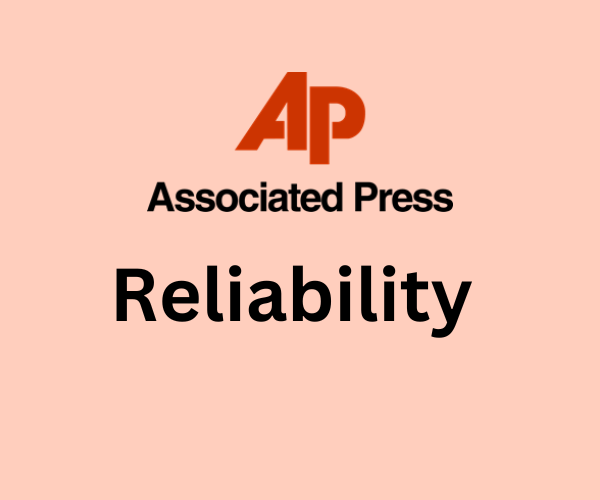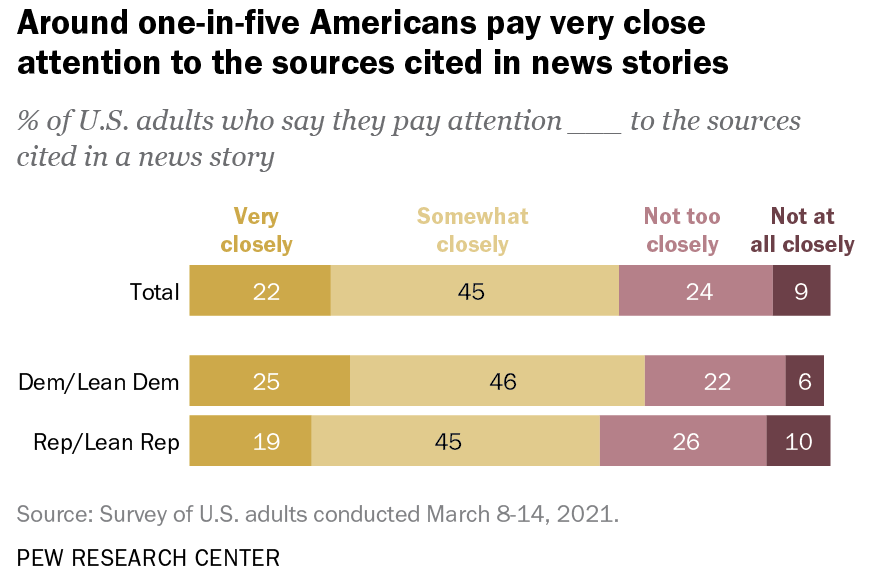
According to Biasly, the Associated Press has a bias of Somewhat Liberal and a reliability score of Good. Although the AP is an established and well-known news source, it is still important to ensure that its news and facts are reliable.

Source: Pew Research
As seen by the work done at Pew Research, a large number of American adults make note of the sources used in news articles. Trust in news stems from the reliability of the sources journalists use to report on current events and issues. Reliability stems from factors such as accuracy and selection/omission. In this article, we will examine how these factors are present in the Associated Press’ articles and determine how reliable they are.
Does Reliability Matter?
Reliability, in general, refers to how trustworthy or accurate information, or in this case, a news source is. If we consider this definition, it quickly becomes clear why reliability is important in media sources. If we can’t trust the things we read then there isn’t much of a point in continuing to consume content from that source, after all. So how exactly can we gauge the reliability of a news source anyway?
There are several potential measures of reliability to look out for when trying to determine whether a media source is reliable or not. Red flags for an unreliable article can include the presence of wild unsubstantiated claims, facts dependent on other unreliable sources, heavy use of opinionated language, and more. Some indicators of a reliable news source, on the other hand, include things like:
- Absence of subjective/opinionated language in articles
- Credible sources cited (e.g., neutral sources, .gov, .edu websites)
- Facts and statistics backed by multiple relevant outside sources
- Use of primary sources when possible (e.g., interviews, quotes)
- Information that remains consistent across news sources
So How Does The Associated Press Fare in its Reliability?
The political reliability index developed by Biasly objectively assesses news organizations’ accuracy and trustworthiness. The Associated Press’ overall Reliability Score has been rated as ‘Good’ by Biasly. This rating is a weighted average of two distinct scores: the Fact Analysis Score and the Source Analysis Score, each evaluating separate components of the Associated Press’ Reliability. When computing the Average Reliability of the article the Fact Analysis score is more heavily weighted. These ratings are as follows in the next two paragraphs:
Associated Press’ Fact Analysis Score is ‘Good,’ which suggests readers can trust most of Buzzfeed’s content online. The Fact Analysis score focuses more on the accuracy of claims, facts, and sources presented in the article and any hints of selection and omission bias, which we will discuss further in the article.
Associated Press’ Source Analysis Score is ‘Fair,’ which suggests readers can trust some of the sources, links, and quotes provided by the news source. This score, which is based on A.I., focuses on assessing the quality of sources and quotes used including their number, lengths, uniqueness, and diversity.
Associated Press Accuracy and Reliability
News companies are under constant observation regarding possible pitfalls when it comes to their accuracy and reliability. In a society where misinformation is prevalent, it is important to ensure that the news is accurate and reliable. To better understand the extent of these two factors about the Associated Press’ work, we will focus on accuracy and selection/omission ratings.
Selection bias is when stories and facts are selected or deselected, often on ideological grounds, to create a narrative in support of the new sources’ ideology. Omission bias, on the other hand, is when different opinions and political views regarding a situation are left out so that the reader is only exposed to the ideological perspective supported by the author. It’s important to keep in mind these two types of biases when trying to assess an article’s level of accuracy.
Biasly assigns a percentage score to accuracy, with one being the least accurate and 100 being the most. Ratings are calculated by weighing assertions with supporting evidence, the number of reliable internal sources, and the number of reliable external sources employed. News sources can vary by article when it comes to their accuracy.
A contrast to the Associated Press would be the Time. Biasly rates it as a Somewhat Liberal news source while having an overall reliability score of Good. One of their articles, “The Mob Comes for Liz Cheney”, had a reliability rating of Fair. In another example, “At a Low Point in His Presidency, Biden Plots a Path Back”, analysts at Biasly rated its reliability as Good. Both articles show that Time is not consistent with its reliability when reporting news.
In contrast, we can examine an article by the Associated Press. “Pelosi Taps DC National Guard Head to Lead House Security”, was rated as Good when it came to its reliability. In terms of bias, it is rated as Center. Mary Clare Jalonick explains why Pelosi picked Major General William Walker to become the next commanding general of the D.C. National Guard. The article consists of Walker’s testimony in a Congressional hearing. For example, Jalonick writes that Walker told Congress:
“he immediately relayed the request to the Army but did not learn until after 5 p.m. that the Defense Department had approved it”
In addition to Walker’s testimony, Jalonick added quotes from individuals from both sides of the aisle. These included high-ranking officials such as Speaker of the House Nancy Pelosi and House Republican Leader Kevin McCarthy.
“It is essential that we work to strengthen our institution and keep our Capitol community, and all who visit, safe,”
“Every member, staffer, employee, and visitor to the Capitol should feel safe with Maj. Gen. Walker at the helm of Sergeant at Arms operations,”
It is important to note that this article is about the events that occurred at the Capitol on January 6th, 2021. Those events have become a contentious issue in politics and reporting has seen bias in all directions. Adding these quotes that represent positive endorsements of the candidate from a Democrat and Republican explains the Center rating that the article received.
The combination of Walker’s testimony, accounts of what went wrong on January 6th, and accounts of endorsements for Walker leave no room for interpretation. It is clear that there were security issues and that Walker has a plan to fix them. The well-rounded reporting in this article shows that it meets the Good reliability rating Biasly gave it.
Analysis of Reliability in Associated Press News Pieces
It is important to analyze the reliability of news pieces published by the Associated Press because of its prominence in the field. Although Biasly gave the AP a score of “Good” on overall reliability, it will be helpful to examine a few examples and see where the Associated Press excels and where improvement can be made.
Quality of Sources and Facts Used
Articles can increase their reliability based on the quality of sources and facts that are used.
Additionally, analyzing the number of quotes and the length also influences an article’s perceived reliability. Let us examine this article: “Pence Proud of His Role Certifying 2020 Election Results.” The article focuses on former Vice President Mike Pence’s opinion about his role in ensuring the certification of the 2020 election. Multiple quotes vary in length. Quotes come from Pence and two individuals who were attending the conference where Pence was speaking. Their quotes were taken from questions the reporter had asked them about their opinion of Pence.
- Joseph Quiroz, an accountant from Pasadena, California (Says he is a Republican)
- Bob Refer, retired policeman (Says he is a Republican)
The number of sources in this article is low as it mainly contains information from Pence’s current and past speeches that touch on the events of January 6th, 2021. However, considering that the source is the Vice President himself, they are highly credible and primary sources.
Omitting quotes from prominent figures on both sides in regard to what Pence did on that day is harmful to the reliability of the article. It would have been helpful for the reader to understand the broader view of Mike Pence rather than how he views himself. Furthermore, the two quotes from conference attendees, Joseph and Bob, are a helpful addition. However, it does not give the reader the full picture. Asking Democrats and Independents for opinions on Pence would have made the article well-rounded.
“I think he’s too nice a guy. He’s not forceful enough.”
The quote above is from Bob Refer, who says he is a Republican. It represents a common opinion among SOME Republicans but not all. Omitting quotes from Republicans who view Pence in a negative light would help readers better understand the general conservative opinion of Pence. As said previously, it would have been beneficial to add quotes from Democrats and Independents in regard to Pence. Only having quotes from Republicans prevents readers from coming to a knowledgeable conclusion about the Vice President and his actions.
The quality of the sources is good as they are statements made by Mike Pence during different speeches. Furthermore, the quotes from Joseph Quiroz and Bob Refer were asked by one of the authors. All three sources have credibility because it was the spoken words of the individuals. The authors are unable to change Pence’s speech or people’s opinions to fit a possible narrative.
Selection and Omission Bias
For another example, let’s examine an article titled, “Election Bill Defeat Revives Fight Over The Filibuster.” The article covers a discussion about the state of the filibuster after the For the People Act failed to pass in the Senate after Republicans employed a filibuster.
Throughout the article, only the views of those who oppose the filibuster are mentioned. Tre Easton works for Battle Born Collective, a group that has sought to see the filibuster removed from the Senate. In response to this renewed debate, he said:
“Now you see what a filibuster does to a Democratic agenda.”
The author’s selection of this quote immediately presents a left-leaning tilt to the article. Adding a statement that portrays the filibuster as a factor that blocks the Democrat’s agenda is not showing the full picture. There can be cases where the filibuster could damage the Republican agenda when Democrats are the minority in the Senate. Rather than acknowledging that possibility, the author leans into the arguments Senate Democrats are making against the filibuster.
“This is not some kind of game,”
This quote from Democratic Senator Amy Klobuchar is another example of the author indirectly choosing to support the left-leaning stance against the filibuster. Portraying the filibuster as an unserious tool that is only used for political reasons rather than legislative further shows it in a negative light. The use of such quotes does not allow the reader to form a fair opinion about the filibuster.
Only discussing the views of Democrats adds to issues of reliability. Omitting the opinions of right-leaning individuals and groups is a disservice to the reader. More specifically, the author does not add statements or mention why Republicans decided to use the filibuster. For example, there could have been a statement where Republicans claim to use the filibuster to force an amendment to the bill. Instead, readers will never know the Republican side of this event.
Such issues with articles make it harder to find reliable news. It is important to pay attention to possible selection and omission bias. These biases can prevent readers from getting the full picture which can affect their understanding and opinion on issues.
| Article | Sources and Facts | Selection and Omission |
| “Pelosi Taps DC National Guard Head to Lead House Security” | ● First-person testimony from the subject of the article ● Includes quotes from people on both sides of the political aisle | ● Uses testimony as a way to describe the events and leaves no room for interpretation ● The use of different viewpoints brings a well-rounded approach to the issue |
| “Pence Proud of His Role Certifying 2020 Election Results.” | ● The low number of sources but are interviews from those who heard the speech ● Facts about Pence and his beliefs came from multiple speeches he gave | ● Could have added quotes representing Republicans who do not like Pence ● Adding perspective from left-leaning individuals would have given readers a broader consensus on Pence |
| “Election Bill Defeat Revives Fight Over The Filibuster.” | ● Inadequate use of quotes as they come from one side of the issue | ● Did not include the views of those who support the filibuster ● Only shows Democrats who are against it and talk negatively about the issue |
So Is the Associated Press Reliable?
The Associated Press can be considered a mostly reliable news source because it has shown it can be neutral when it comes to news reporting but appears to be slightly left according to Biasly’s bias rating. However, their news pieces do pose issues of reliability because of source and omission problems. Because of this, using Biasly’s News Bias Checker will assist you with ensuring that the news articles you read are reliable and provide you with correct information.






















